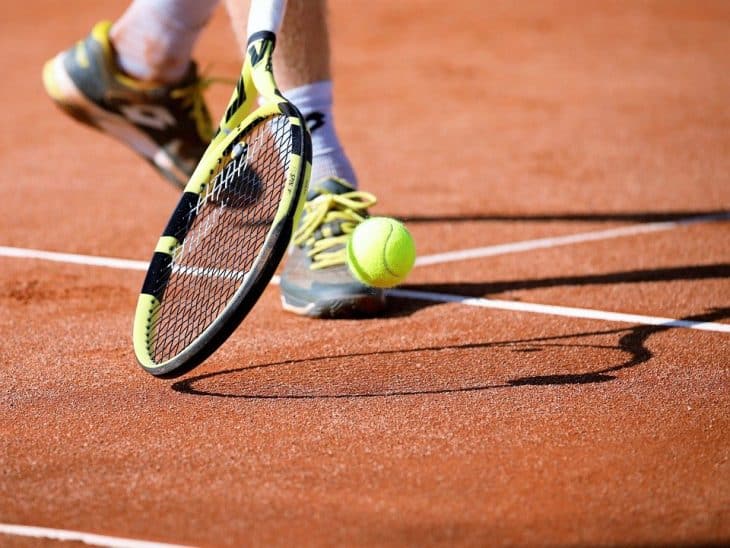
Tennis is one of the most popular sports in the world. A testament to this is the thousands of people who tune into the Olympics to watch and cheer for their favorite tennis players. However, it isn’t always easy to understand what is happening in the game because of the complicated tennis terms.
Luckily, this list of tennis terms can help you follow the game like a pro. Whether you’re a beginner or a casual fan of tennis, you’ll find this list useful.
What is tennis?

Before diving into the different tennis terms, it is important to define what tennis is first. Tennis is a popular racket sport that is played with at least two players.
A racket sport refers to types of sports that require using a racket to hit an object toward another player or team. In badminton, players hit a shuttlecock using their badminton racket. In tennis, players hit a ball using their tennis racket.
What is the history of tennis?
Some people believe that tennis originated in northern France in the 12th century. In France, people often played jeu de paume, which means “game of the palm.” As the name suggests, players strike a ball with the palm of their hand.
Louis X and his companions originally played the game outdoors, despite disliking that he has to. By the end of the 13th century, he had indoor courts built for his games. His indoor courts served as inspiration for the tennis court as many copied the design until it spread across Europe.
Around the 16th century, people started using rackets, and this led to the development of indoor tennis. However, players eventually lost interest in indoor tennis, and the game lost popularity.
On the other hand, some people believe modern tennis originated much later in 19th century England. In 1872, Harry Gem and his companions established the first tennis club together. At the time, people referred to tennis as “lawn tennis” because they played it outdoors.
However, most people recognize Walter Clopton Wingfield’s guide as the first official record of modern tennis. Wingfield published a set of rules for tennis in 1873, which he later patented in 1874.
Tennis continued to gain popularity in England in the 1800s as championships were hosted. Soon, it reached the United States after a couple of players brought their rackets with them to New York.
Today, tennis has become a popular sport that people of different races, genders, and ages play. Both professionals and hobbyists can play this sport. As a competitive sport, there are plenty of competitions that offer players a chance to compete internationally, such as the Grand Slam tournaments, the Olympics, and the Paralympics.
Its popularity doesn’t just come from competitive play. In fact, there are plenty of pop culture references that involve tennis. One example is from the popular anime, Prince of Tennis. Plenty of films also feature characters who play tennis, such as The Royal Tenenbaums (2001) and Wimbledon (2004).
In literature, you can find references to tennis in William Shakespeare’s Henry V. You can also find plenty of video games that simulate tennis, such as Mario Tennis and Wii Sports.
Basic Rules of Tennis
Each sport has its own set of rules players must abide by. Otherwise, penalties will be incurred, such as score deductions and, in severe cases, disqualifications. When it comes to competitive play, there are more specific rules that players must be wary of. However, for beginners, these basic tennis rules are a great place to start.
Wear the appropriate attire for tennis.
Some tennis clubs can be strict when it comes to tennis attire. They require players to wear sportswear specific to tennis. Otherwise, they do not let people play on their court.
Sportswear for tennis includes short-sleeved cotton shirts and tennis shorts. For women, they can opt to wear a sleeveless cotton top with a tennis skirt. For shoes, players are encouraged to wear tennis shoes.
Tennis shoes are easy to run and jump in, especially on tennis courts. However, if you are a beginner and do not have tennis shoes, you can just wear any comfortable sports shoes.
Players cannot touch or cross the net.
This includes the posts that hold the net upright. Touching the net with their hands or racket means a penalty.
Crossing the net to go to the opponent’s side is also not allowed. This means players must always be aware of staying within their side of the court as well as keeping an eye on the distance between them and the net when hitting the ball.

Players cannot catch or carry the ball with their racket or hands.
Just like volleyball, tennis prohibits players from catching the ball. In tennis, players cannot catch the ball with their hands or their racket. To keep the ball in play, players must always hit the ball with their racket. Otherwise, the player loses points.
Players cannot let go of their racket during a game.
Tennis players can think of their racket as their lifeline during a game. Without it, they cannot play the game.
This rule is also kept in place to minimize violence between players. For instance, some players might attack other players using their rackets in a fit of rage. There could be a danger of rackets being thrown at the opponent or the umpire. When this happens, the official can call for a severe penalty, such as disqualification.
The ball must bounce once before the player can return it.
Another common mistake for beginners is hitting the ball too early. Some might hit the ball before it completely crosses over the net. However, even if it bounces back to the opponent’s side, this does not count.
A ball must first bounce on your side once before you can return it to the other side. Keep in mind that the ball can only bounce once. If it bounces twice, your opponent gains the point.
Players can only hit the ball once.
In billiards, players can only hit the cue ball once with their stick during their turn. In tennis, it is the same. You cannot hit the ball twice. After the ball bounces once on your side of the court, you must hit it hard enough to cross the net over to your opponent’s side. Hitting the ball two or more times results in a lost point.
With the definition, history, and rules out of the way, it is now time to go over the different tennis terms. If you’re interested in learning the equipment, gameplay, and scoring terms, then this tennis terms list is just for you!
Tennis Terms: Equipment, Area, and Personnel
Basic tennis terms involve the equipment, tennis court, and personnel that you will see in most games. Learning about these terms first will help you better understand the specific tennis score terms and gameplay.
Ball
The balls in tennis differ from those in other ball sports. A tennis ball is filled with air and has a cover made of fibrous felt. The felt gives the ball better flight properties that suit the gameplay of tennis.
The International Tennis Federation (ITF) standardized the dimensions of the ball for uniformity. It has a diameter of around 2.5 inches and weighs around 2 ounces.
For competitive play, the tennis ball must be yellow. In casual and recreational activities, other colors, such as white, can be used.

Tennis Racket
A tennis racket, sometimes spelled racquet, is the tool a player uses to hit the ball in a tennis game. When learning tennis terms, you can’t forget the basic parts of a tennis racket. These are the head, the shaft, and the handle.
These major parts also have several subparts. For instance, the head comprises the rim, bumper guard, and strings. Meanwhile, the shaft comprises the throat. Last, the handle includes the grip, butt, and butt cap of the racquet.
While they might look similar to badminton rackets, tennis rackets still differ in many ways. For instance, tennis rackets are larger and heavier than badminton rackets. A tennis racket also has a larger head and a shorter throat. Its grip is also much thicker than a badminton racket.
Court
As far as tennis terms go, the tennis court is the easiest one to spot. It is the large playing field where the game occurs. Tennis courts are usually grass courts. However, there are also courts made from hard clay.
The dimensions of a tennis court vary, but the International Tennis Federation (ITF) requires a certain standard when it comes to tennis courts.
Tennis courts where tournaments occur must be rectangular. The length should be 23.77 meters long. The width of a tennis court will depend on whether it is meant for a game of doubles or singles. For doubles, the court should be 10.97 meters wide. For singles, the court should be 8.23 meters wide.
Net
The net stands in the middle of the tennis court. It divides the court into two sides, with one side for each player or team. Players have to hit the ball over the net for the ball to cross over the opponent’s side.
Baseline
If you look at a tennis court closely, you’ll notice several lines marking different sections of it. One of these lines is the baseline. At the back of the court is the baseline. It runs parallel to the net and is perpendicular to the sidelines.
Service Box
You’ll notice two boxes on each side of the court. They are close to the net in the forecourt and are called service boxes. A service line runs horizontally to mark the end of the service box.
There are left and right service boxes and the player stands in one of them when serving the ball. If the player stands in the left service box, then their serve must land diagonally to the right service box.
Tramlines
Tramlines are the outermost lines on the court. They run parallel to the singles lines. These external lines mark the boundary for balls that are considered “out.” However, this only applies to a game of singles. For doubles, officials will count balls that fall before the tramlines as “in.”
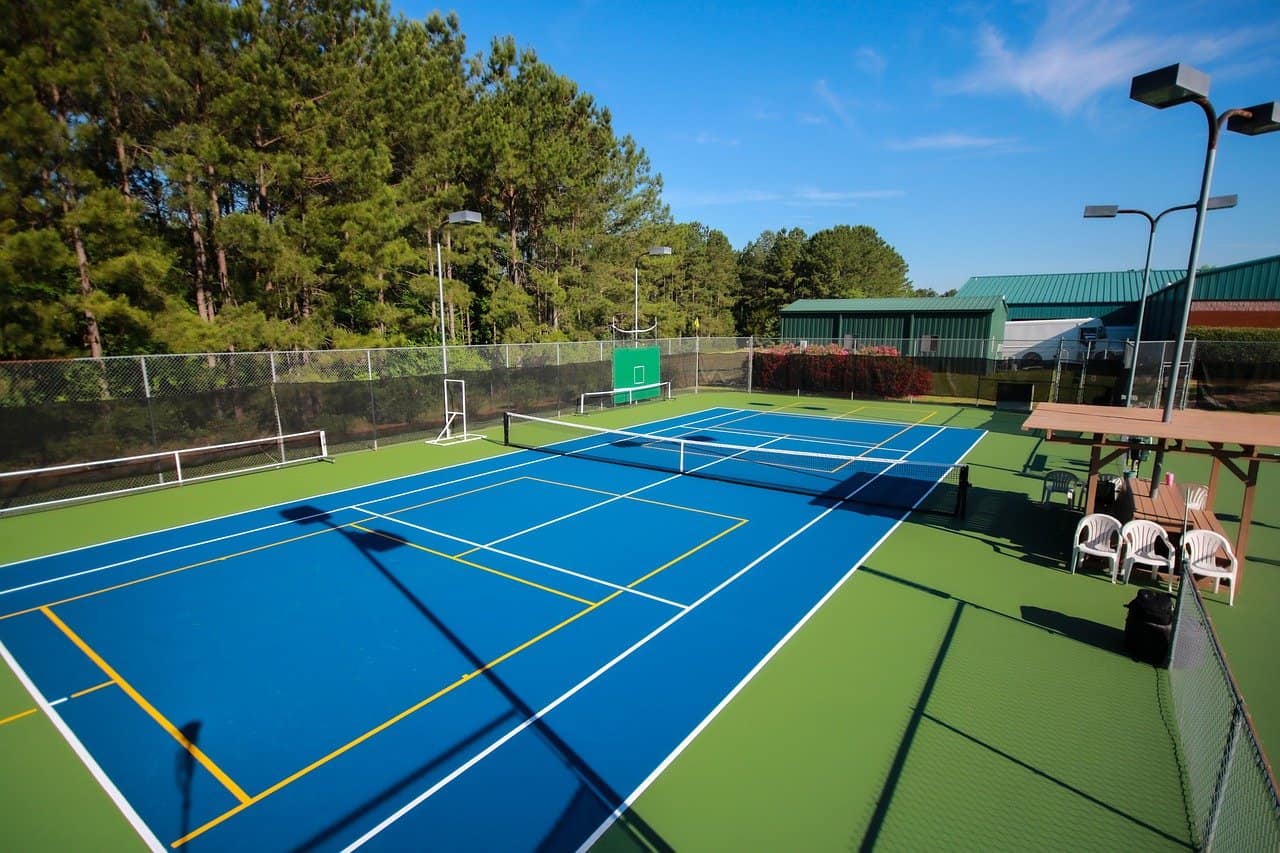
Alley
The alley refers to the area between the singles and double sidelines. There is an alley on each side of the court. The alley is an additional area that allows for a bigger court when players engage in doubles play.
Ad Court
The ad court refers to the receiving player or team’s left side of the court. This means that the ad court differs depending on the player or team’s orientation.
The ad court also refers to the side where a player who is leading in the game is serving from. This meaning comes from the “ad” in “ad court,” which stands for advantage.
Deuce Court
Opposite the ad court is the deuce court. In tennis terms, the deuce court refers to the right side of a player or team. This depends on the player or team’s orientation, so your deuce court differs from your opponent’s deuce court.
Backcourt
A basketball court also has a backcourt, which refers to the half of the court where the basket is. In a tennis court, the backcourt is the area in between the baseline and the service line. It is the furthest from the net, and it marks the boundary for “in” services.
Ball boy
As for tennis terms for personnel you see at tennis games, one example is the ball boy. The ball boy, sometimes called ball girl or ballkid, is the person who collects the tennis balls from the court. When a tennis ball falls out of bounds or is not received by a player, the ball boy retrieves it to give back to the serving player.
Ball boys are usually children, and there can be more than one ball boy for each tennis court.
Line judge
As the name suggests, the line judge observes whether the tennis ball is within or out of bounds. They usually make the call of who loses the point, and the players cannot disregard their ruling. However, an umpire can overrule the line judge’s call as the umpire makes the final decision.
Other names for the line judge include linesman, lineswoman, and line umpire.

Net cord judge
Another tennis official is the net cord judge. The net cord judge stands close to the net, and they determine whether the serve hits the net. In the 1990s, however, official games by the Association of Tennis Professionals removed net cord judges from their matches. Several organizations followed this move after, so net cord judges are no longer part of competitive plays.
Chair Umpire
One of the most common tennis terms is the umpire. The chair umpire, or simply umpire, is the official who enforces the rules of the game and keeps track of the scores during the match. The umpire is also in charge of making calls for penalties and other contentions.
The umpire’s ruling is above the other officials in the game, such as the line judge and the net cord judge.
Tennis Terms: Gameplay
Tennis gameplay terms can get confusing. However, it is important to understand them to better understand the game itself. Whether you’re just watching a game or playing one yourself, learning the tennis terms for gameplay could mean victory.
Ace
In tennis terms, an ace refers to a perfect serve. It is like the ace in volleyball. If an opponent failed to receive the serve and the serve is considered in, then the player’s serve is an ace.
Approach Shot
When a player follows a ball to the net for a shot, then the player executes an approach shot. For instance, a player moving forward from the backcourt to hit the ball near the net is doing an approach shot.
A player needs to be mindful of their distance from the net. Otherwise, they might accidentally touch the net with their racket during their approach shot. This would then lead to a loss of point.
Backhand
Did you know that there are strokes in tennis too? Of course, the stroke in tennis terms differs from a stroke in medical terms and a stroke in swimming terms.
In tennis, a stroke refers to the movement of swinging the tennis racket. A backhand is a type of stroke where the player uses the back of the racket to hit the ball. Usually, right-handed players will do a backhand to receive a ball on the left side of the court.
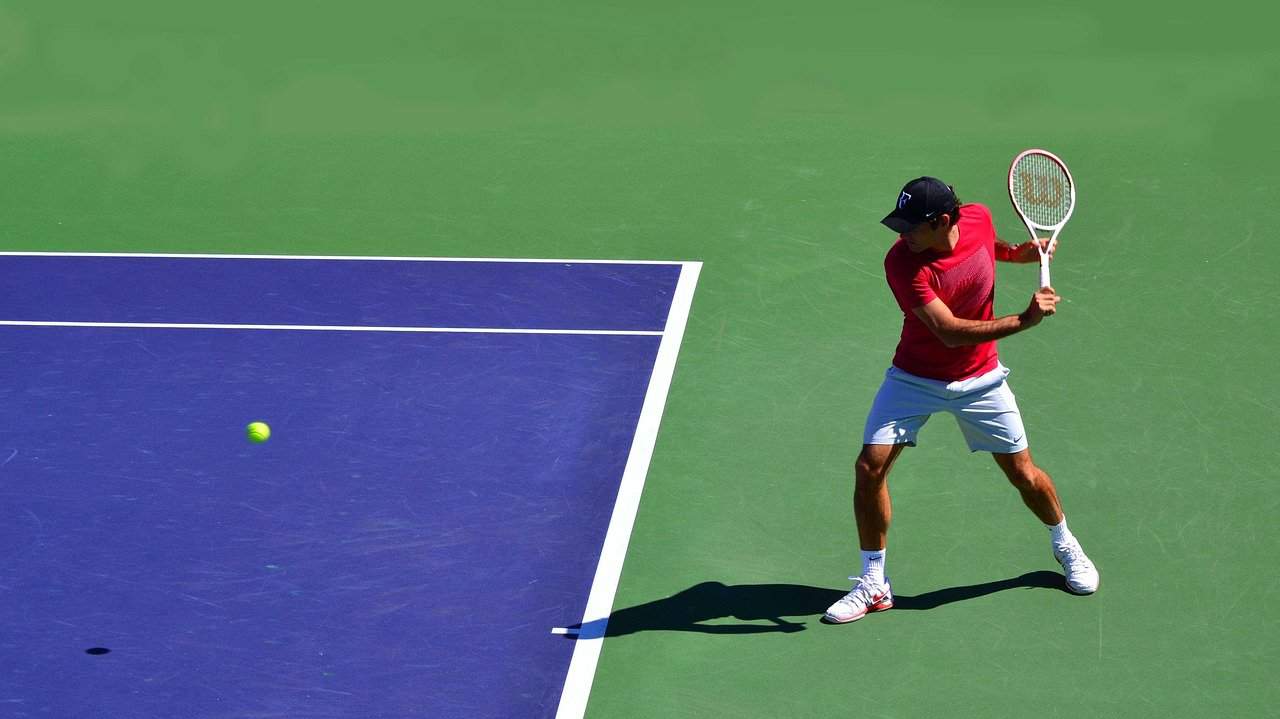
Backspin
As the name suggests, a backspin occurs when the ball rotates backward after the player hits it. The spin affects the trajectory of the ball, causing it to be lower than normal shots.
Other names for the backspin include slice and underspin.
Ball Toss
When a player throws the ball up to prepare for their serve, they perform a ball toss. A good ball toss is necessary for a good serve. A ball toss that is too high or too low can result in a fault.
If you want to get a good start in a rally, then practicing your ball toss and serve is important!
Break
Usually, whoever serves the ball is more likely to score the point at the end of the rally. If you’re the receiving player, however, you don’t have to lose hope. You can still aim for a break. In fact, a break is often one of the key moments in a game that audiences and players remember the most. A break happens when the receiving player or team wins the game. In doing so, they “break” the serve.
Call
In tennis terms, a call refers to the judgment an umpire or line judge makes when determining whether a ball lands inside or outside the court. It can also refer to the call an umpire makes on other matters, such as faults, lets, and other errors a player can make.
Cross-Court Shot
A cross-court shot is a type of shot where the player hits the ball diagonally. For example, when a player hits a cross-court shot from the right side of the court, the ball will travel in a diagonal direction. It will land on the left side of the opponent’s court. From the opponent’s orientation, this would be their right side.
Deep Shot
This happens when a ball lands near the baseline instead of near the net or service line. The name comes from how the ball lands “deep” into the opponent’s side of the court. Some players might be caught off guard by a deep shot and lose a point because of it.
Doubles
A doubles match refers to a game between two teams, with each team comprising two players. Usually, competitive plays will have separate tournaments for men and women. This means that men compete with men while women compete with women.
Outside of competitive play, however, mixed doubles are possible. In mixed doubles, each team comprises one man and one woman.

Down the Line Shot
As the name suggests, a down the line shot refers to a shot made that hits the sideline of the opponent’s side of the court. A successful down the line shot can often lead to a point for the player as it is very difficult to receive. Even seasoned professionals find it difficult to receive a down the line shot sometimes.
Error
An error refers to a shot that fails to land correctly on the opponent’s side of the court. This will result in a loss of point for the person who hit the shot.
Fault
People often confuse error with fault. While an error refers to an unsuccessful shot, a fault refers to a failed serve. When a player’s serve doesn’t land on the opponent’s service box, then the serve is a fault. This results in a point loss for the serving player.
A double fault refers to two faults in a row.
Forced Error
In tennis terms, a forced error occurs when a player hits a shot so well that the opponent is unable to receive it. In other words, the player “forces” their opponent to miss the ball. This is why it is called a forced error.
Forehand
Like the backhand, the forehand is another type of stroke. In a forehand, the player hits the ball using the front of the racket. It is the opposite of a backhand. For beginners, a forehand is one of the first types of strokes that they learn.
Foot Fault
One type of fault in tennis is the foot fault. A foot fault happens when the player accidentally steps on or over the baseline during their serve.
Follow Through
In tennis terms, a follow through refers to how you finish your stroke. This is right after you hit the ball. There are different follow throughs for different types of strokes. There are follow throughs where you finish with your racket in front of you or with your racket over your shoulder.
The position of your racket after you hit the ball is very important as it can indicate whether you hit the ball correctly. If you’re practicing your strokes, then it is important to get your follow throughs correct too!
Grip
A grip refers to the way a player holds their racket. There are several types of grips, but the most common are the Eastern Grip, Western Grip, and Continental Grip. Throughout a game, a player can change their grip depending on the shot they want to hit. This is because some grips suit some shots better.
Groundstroke
A groundstroke is one of the major types of stroke. A groundstroke happens when the ball bounces on the player’s side of the court before they hit it. This only includes balls that are “in” bounds. Forehands, backhands, and slice backhands all fall under this category.
Jamming
In tennis terms, jamming refers to hitting the tennis ball straight toward your opponent’s body. When this happens, the opponent is unable to hit the ball well because the ball’s trajectory limits their movement. They can’t stretch their arm well to make a proper receive.
Kick Serve
A kick serve is a type of serve where the player hits the ball so that it has a lot of spin. The spin causes the ball to bounce higher than usual. Catching your opponent off guard with this serve can lead to an ace.
Another name for the kick serve is the American twist. This is because the kick serve originated from the United States.
Let
One of the most common tennis terms is the let. A let happens when a player’s served tennis ball hits the net but still manages to land in the opponent’s service box. While this does not count as a fault, the player must serve again.
The umpire can also call for a let during instances where outside factors interrupt the player’s service.
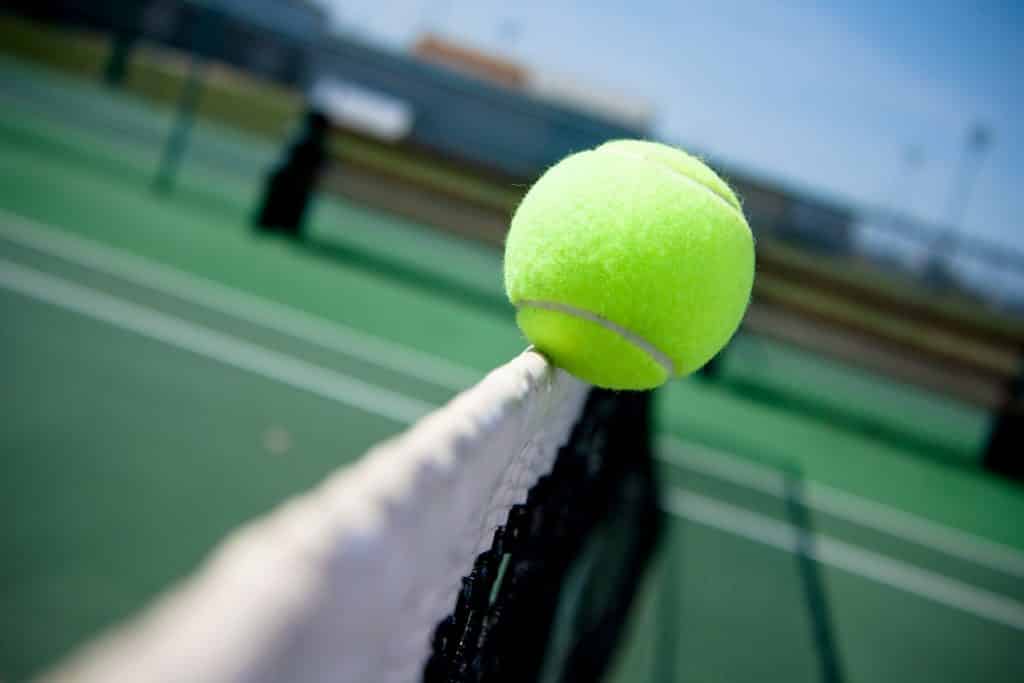
Lob
When a player’s shot lifts the ball high above the net, this is called a lob. A lob is another type of stroke, and it can either be an offensive or defensive shot. It depends on the player’s intentions.
When the opponent is near the net, the player can hit a lob. This forces the opponent to chase down the ball and give the player time to get back into position. This counts as a defensive lob.
For an offensive lob, the player can hit the ball high above the net to score a point. Usually, a player will hit a lob when the opponent is close to the net. This can often frazzle the opponent and make it difficult for them to receive the stroke and hit it back.
Rally
A rally can refer to different things. In tennis terms, however, a rally refers to the series of consecutive shots between opponents. A rally starts after a successful receive of a serve and ends when one of the players fails to hit the ball back to the opponent’s side of the court.
In simple words, it is the back and forth of the tennis ball between the opposing players or teams.
Receiver
The receiver in a tennis game refers to the player who receives the opponent’s serve. Since serves in tennis also revolve, the player will shift between playing the role of the receiver and server for certain points.
Return
A return refers to the stroke a receiver makes. In other words, a player executes a return when they are on the receiving end of the opponent’s serve.
Retirement
When a player withdraws during a match, this is called retirement. They forfeit and “retire” from the current game. This usually happens when a player suffers an injury that inhibits them from continuing.
Retirement can be shortened to simply “ret.”
Serve

Serve is one of the first tennis terms you’ll learn when you are a beginner. A serve refers to the stroke that starts each point in tennis. A serve must land in the opponent’s service box. Otherwise, this results in a fault.
The word, “serve,” acts as both a verb and noun in tennis, so it can refer to the action or the act of serving.
Spin
In tennis, spin refers to the rotation of a ball after it is hit. The spin of a ball can affect its trajectory and bounce. This means that a spin can make your hit ball travel higher or lower during a stroke.
Some types of spins include topspin, underspin, and backspin. Spin is also a synonym for action.
Walkover
While retirement is a mid-match withdrawal, a walkover occurs when the player withdraws before the match even starts. A walkover will result in an “unopposed victory” for the remaining player. Walkovers usually occur due to injuries or accidents before the tournament.
Walkover can be shortened to “WO” or “w/o.”
Tennis Terms: Scoring
This last section focuses on the different tennis score terms. These terms might be the most confusing part when it comes to understanding the game. This is because the scoring system, and therefore the scoring terms too, are unique.
Of course, you don’t have to worry. Just like the previous sections, the next tennis terms and definitions are made easy to understand for beginners!
15
When a tennis player scores their first point, their score is not 1 but 15. If the player’s opponent wins their first point in the next turn, then the game is currently “15-all.” This scoring system shows how unique tennis is from other sports.
30
Following the logic of 15, you can probably guess that a 30 in tennis terms doesn’t actually mean the opponent missing 30 strokes. In tennis, a score of 30 means a player won two points in the game.
40
When a player wins their third point in the game, their score isn’t 45. In tennis terms, three points are equal to 40. Since a tennis match is often a race to four points, then the player wins the game with the next point they score after 40.
Deuce
Of course, it isn’t always easy to score that winning point after 40. A deuce can occur just when you think a game is going your way.
A deuce happens when both players have a score of 40. When this happens, a player has to win two consecutive points to end the game with a win.
Advantage
In tennis terms, advantage refers to the point a player wins after a deuce. It is called an advantage because the player is leading, and only one more point is needed for the player to win the game.
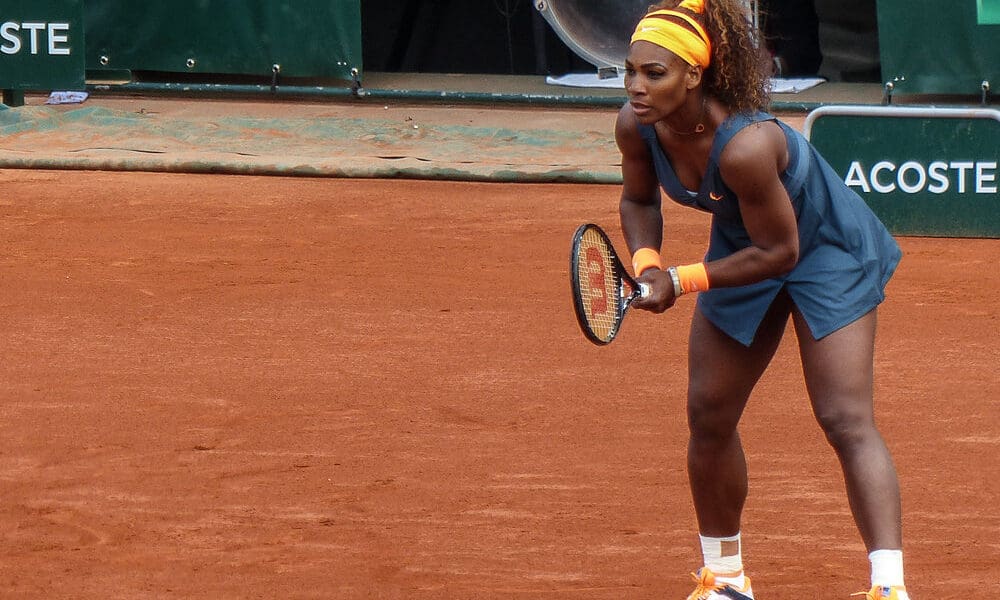
Double Bagel
A double bagel isn’t just a popular order at your local bakery. In tennis terms, it means a score of 6-0-6-0. It is a match with two sets, where each set is first to six. When one player consistently wins both sets with six points, this results in a score of 6-0-6-0 or a double bagel.
Game
In tennis, a game refers to the sequence of points that two players or teams play against each other. A serve marks the start of a game, and the game ends when one of the players wins the point.
At least six games make up one set in tennis.
Love
Love is a word that many know and use. Most people want nothing more than love and affection in their lives. Tennis players, however, want to avoid love at all costs. You might be wondering why that is.
In tennis terms, what is “love” exactly? Love refers to a score of zero. For instance, when someone says they are currently losing the game with a score of love-15, they mean a score of 0-15.
Match
In tennis terms, a match refers to a competitive play between two players or teams. A singles match refers to a match between two players, while a doubles match refers to a match between two teams.
Usually, professional tennis matches are a best of three or five sets.
Set
A tennis match comprises a series of sets. On the other hand, a set comprises a series of games, usually six. When both players reach a score of 6-6 in a set, then a tiebreak occurs to determine who the winner is.
Was this page helpful?
Our commitment to delivering trustworthy and engaging content is at the heart of what we do. Each fact on our site is contributed by real users like you, bringing a wealth of diverse insights and information. To ensure the highest standards of accuracy and reliability, our dedicated editors meticulously review each submission. This process guarantees that the facts we share are not only fascinating but also credible. Trust in our commitment to quality and authenticity as you explore and learn with us.
